The Huawei Mate 9 Review
by Matt Humrick on January 27, 2017 7:00 AM ESTBattery Life
Pairing the efficient Kirin 950 SoC with a reasonably large 4000 mAh (15.28 Wh) battery proved to be a recipe for long battery life with the Mate 8. For the Mate 9, Huawei keeps the 4000 mAh battery in the mix, but tosses in the Kirin 960 SoC instead, which promises even lower power consumption. Its Cortex-A73 CPU cores consume 20%-30% less power than Kirin 950’s A72 cores (same process, same frequency), according to ARM, and TSMC claims its 16FFC FinFET process reduces area and leakage relative to its 16FF+ process used for the Kirin 950.
To see how these changes impact the Mate 9’s battery life, we’ll run it through our standard suite of battery tests. To make the tests accurate and repeatable, we control as many variables as possible, including minimizing background tasks and calibrating each display to 200 nits at 100% APL.
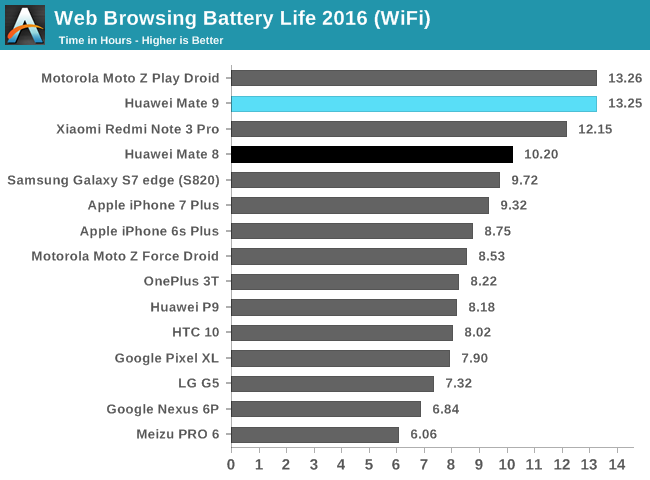
Our Wi-Fi browsing test loads, pauses, and then scrolls through a set of popular websites while connected to Wi-Fi with the cellular radio turned off. While running this test, the Mate 9 manages 13.25 hours of screen on time, a full 3 hours more than the Mate 8 and almost 4 hours more than the iPhone 7 Plus. This represents a 23% reduction in average platform power consumption relative to the Mate 8 (extrapolated from total runtime and battery capacity), a significant drop considering the display is still the primary power consumer in this scenario. The only phone in the chart above that consumes less power on average than the Mate 9 is the Moto Z Play Droid, which has a smaller 5.5-inch SAMOLED display and a Snapdragon 625 SoC with only Cortex-A53 CPUs on 14nm FinFET. For comparison, both the HTC 10 and Galaxy S7 edge consume about 25% more power on average over the duration of the test.
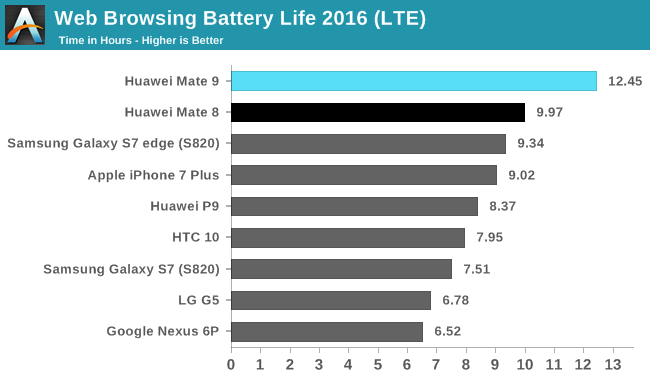
When using the cellular radio instead of Wi-Fi, the Mate 9’s screen on time drops to just under 12.5 hours, a duration 6% less than its Wi-Fi result and still significantly better than the other flagship devices we’ve tested.
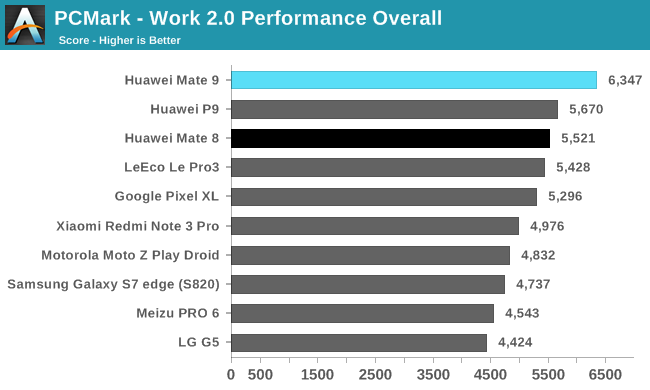
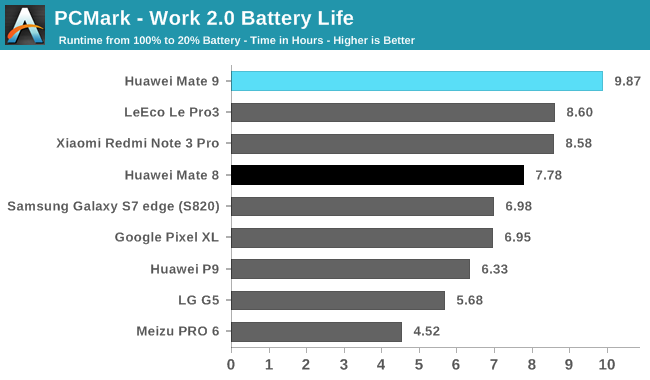
The Mate 9 lasts almost 10 hours when constantly running PCMark’s mixture of everyday workloads, just over 2 hours longer than the Mate 8. This is impressive on its own, but even more so considering it also tops the overall performance chart. As long as you’re not playing games, the Mate 9 easily gets through a full day on a single charge. The LeEco Le Pro3 is the longest lasting phone with a Snapdragon 820/821 SoC thanks to its large 4070 mAh battery.
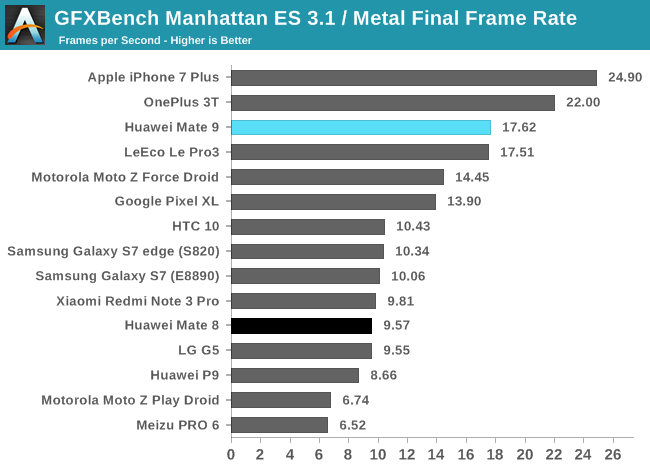

Most of the current flagship phones last around 3.5 hours when playing games, and the Mate 9 is no exception. The Mate 8 lasts 1 hour longer but does so by sacrificing performance; its GPU only has half as many cores after all. As a general rule, the higher the performance the lower the battery life. The iPhone 7 Plus is a good example; it delivers the best performance in this scenario but fails to match the battery life of its peers.
There’s another factor to consider when evaluating gaming battery life: display resolution. Higher resolutions require the GPU to process more pixels and use more power. The iPhone 7 Plus, Le Pro3, Mate 9, OnePlus 3T, and Moto Z Play Droid all use lower-resolution 1080p displays, giving them an advantage in both final frame rate and battery life.
Huawei’s Honor 8 and its lower-performing Mali-T880MP4 GPU are able to maintain peak gaming performance for 42 minutes in GFXBench Manhattan 3.1 before reducing GPU frequency to avoid overheating. In contrast, the Mate 9’s GPU, with twice as many cores, generates more heat, forcing it to throttle exactly 1 minute into the test (which just happens to be how long the performance benchmark runs). Frame rate then drops quickly to 21fps after 8 minutes, a 38% reduction relative to the peak value. It reaches equilibrium after about 30 minutes, with frame rate hovering around 19fps. This is still a significant improvement compared to the Mate 8, Honor 8, and P9, where peak performance hits 11.5fps and sustained performance is between 9-11fps.
The Mate 9’s sustained performance is as good as or better than phones using Qualcomm’s Snapdragon 820/821 SoCs too. The Galaxy S7 edge, for example, also experiences a significant 33% drop in performance starting at the 8 minute mark, stabilizing at about 10fps after 31 minutes. The Moto Z Force Droid, with a newer GPU driver, can sustain a peak performance of almost 18fps for 12 minutes, gradually reaching a steady-state frame rate of 14.5fps. The LeEco Pro 3, which uses Snapdragon 821, can maintain 19fps after dropping from a peak value of 33fps.
Once the Mate 9’s battery level drops to 10% at the 3.1 hour mark, Huawei’s battery saving feature, which cannot be disabled, kicks in, reducing frame rate to 14fps. There’s another step when the battery level hits 4%.
Battery Charging
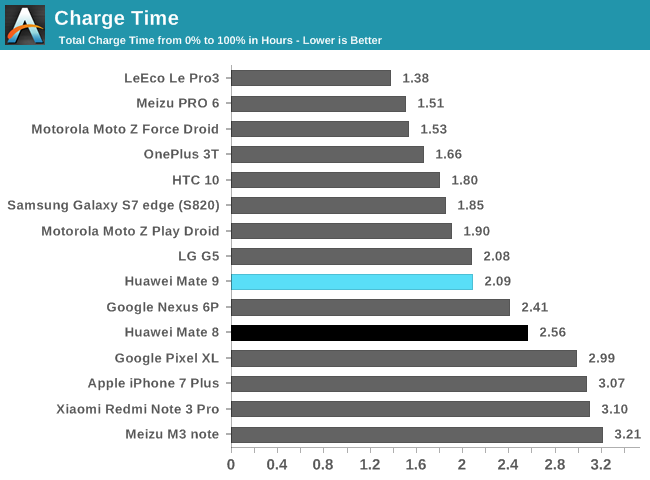
The Mate 9 includes Huawei’s SuperCharge fast-charging technology, which is different than the 18W (9V/2A) charging system used by Huawei’s previous phones, including the Mate 8. This new system charges at up to 22.5W, while still providing voltage, current and temperature protection circuitry. The included wall charger is rated for 5V/2A (10W), 4.5V/5A (22.5W), and 5V/4.5A (22.5W) operation.
The Mate 9 reaches a peak of 20.2W at the battery shortly after being plugged in. The peak charging period lasts just over 20 minutes before ramping down linearly into a trickle charge phase. The battery charges to 25% in about 12.5 minutes and reaches 50% in about 25.5 minutes. For comparison, the Mate 8’s 18W fast-charging system (with the same size battery) charges its battery to 50% in 41 minutes. Unlike some phones, the Mate 9 continues to fast charge even when the screen is on and you’re using the phone.
A full charge takes 2.09 hours, 28 minutes faster than the Mate 8. Motorola’s TurboPower technology charges the Moto Z Force Droid’s smaller 3500 mAh battery to 50% in 19 minutes by pulling up to 24.9W at the battery.
The Mate 9’s battery life is excellent in general and a clear improvement over the Mate 8, which was already very good. It appears to be using a new display that consumes less power than the Mate 8’s panel, helping to reduce its overall platform power in conjunction with Kirin 960’s better efficiency. Unless you do a lot of gaming, the Mate 9 should easily last a day or more on a single charge.


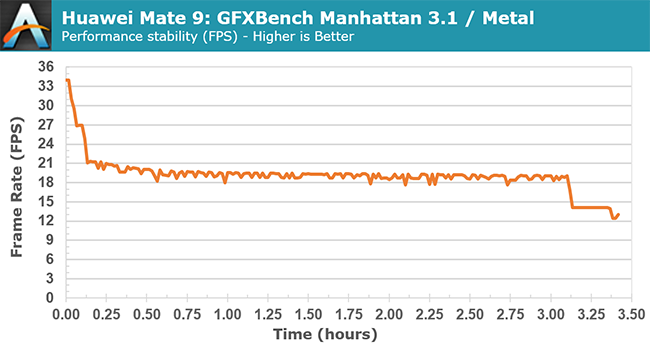









84 Comments
View All Comments
lolipopman - Saturday, January 28, 2017 - link
No mention of thermal throttling, great work, guys!Meteor2 - Saturday, January 28, 2017 - link
?? Read the review more carefully.s.yu - Saturday, January 28, 2017 - link
At least they didn't send the Samsung copycat version over for the review.Shadowmaster625 - Saturday, January 28, 2017 - link
And yet another android SoC gets eaten by apple.cokata1 - Sunday, January 29, 2017 - link
The Mediatek X30 should be a very interesting SoC to take a closer look at. I hope Anandtech does a deep dive for it. 2X A73 @ 2.8Ghz with 4x A53s and 4x A35s all on 10nm process. This should be the first Mediatek SoC that is competitive with the rest when it comes to power/watt, and we will see the A35 for the first time.thek - Sunday, January 29, 2017 - link
Hey look this website isn't dead..UtilityMax - Monday, January 30, 2017 - link
Are you guys also going to review the Huawei Mediapad M3? That was basically the only top-major-vendor brand new Android tablet introduced in the USA in 2016.aryonoco - Monday, January 30, 2017 - link
Anandtech reviews are completely losing sight of what's important.There is a whole section on "Software", where multiple paragraphs are spent talking about what the icons looks like and what this specific highlight color is. And yet there is no mention of stuff that actually matters: What Android security patch level is this thing running? Has the manufacturer committed to providing security updates on a timely basis? For how long?
What's the point of spending $600 on a device that comes with root exploits out of the box?
Now tell me, is prompt security updates not worth even a single mention in a product review?
Matt Humrick - Tuesday, January 31, 2017 - link
I discussed Huawei's update policy in our Honor 8 review, which I linked to in the first paragraph of the software section. As of today, the Mate 9 has the November security patch. Currently, I would say Huawei is about average for releasing security updates and a little below average for releasing OS updates.akdj - Wednesday, February 1, 2017 - link
Matt,I just wanted to drop a quick thanks and throw some shade your way for both a job well done and continued efforts in spite of ridiculous, incessant and from the same family of foolishness ubiquitous throughout technology review and rumor sites, forums and social media.
I'm not alone and I'm sure most here recognize just the recovery time to 'process' sites, sounds - products and future technology gleaned from another CES - which ended just three weeks ago! Not to mention 'Vegas' recovery in and of itself, travel and catch up with, what I'm sure each of you have, that 'other life'! It's obligations, responsibilities and a few hours of sleep --
Not to mention constant communications with different OEMs about product, shipping and scheduling and doing so with the offering of a completely free website run by enthusiasts who possess more knowledge in a broader expanse of tech hard and software than most of us readers and typical but focused enthusiasts interested in other areas and aspects of technology.
IMHO, the job you do for the millions each of you makes yearly;) - is nothing less than greatly appreciated by an exponential percentage that'll ever take the time to post, even register with your site - IOW; you've a huge percentage of 'happy' and 'return' visitors vs. the usually humorous and ignorance displayed by a few in your response and comments. I've long since given up responding to each bozo I disagree with, reserving my attacks for those deserving and spreading unusual, over the top BS about product to perspective users, buyers or legitimate queries
You still host a site second to not a single site when it comes to in depth, well written and researched/combined with real world usage, avoiding time to press pressure... providing amazing, compelling reviews filled with detailed objective and subjective data by authors with obvious enthusiasm for technology and it's constant march in to the future inevitably offering faster, more reliable, durable 'better' product choices every day, week, month, and years that go by...
Some'll still be feeding spiders in mom's basement, drinking Mt Dew with a serious lack of 'outdoor time' - @ 45 years old behind the anonymity of their keyboards waking daily with a single goal in mind. Belittle others, demand from anyone but themselves, and magnify their miserable (yet easily changed, bettered, and enjoyed...) existence online.
As anonymous ghosts empowered by their ability to hide in mom's basement, enjoying a false sense of security while feeding said spider;)
Take care, Happy New Year and hopefully you've had the opportunity to recover from CES, transfer your stills and video and 'thoughts/notes' to the 'mainframe' - with a chance to unwind and debrief! As always, regardless of when the A10 'deep dive' is posted, an in depth essay on the architecture of the new SD-835 or your review of the new MacBook Pro's 15" fully upgraded Touch Bar hits - whether beaten by your ten pages on Dell's XPS 15" - I'll be here, I'll read and guaranteed, I'll enjoy your time, efforts and enthusiasm for a job VERY Well Done
Thanks
Jeremy